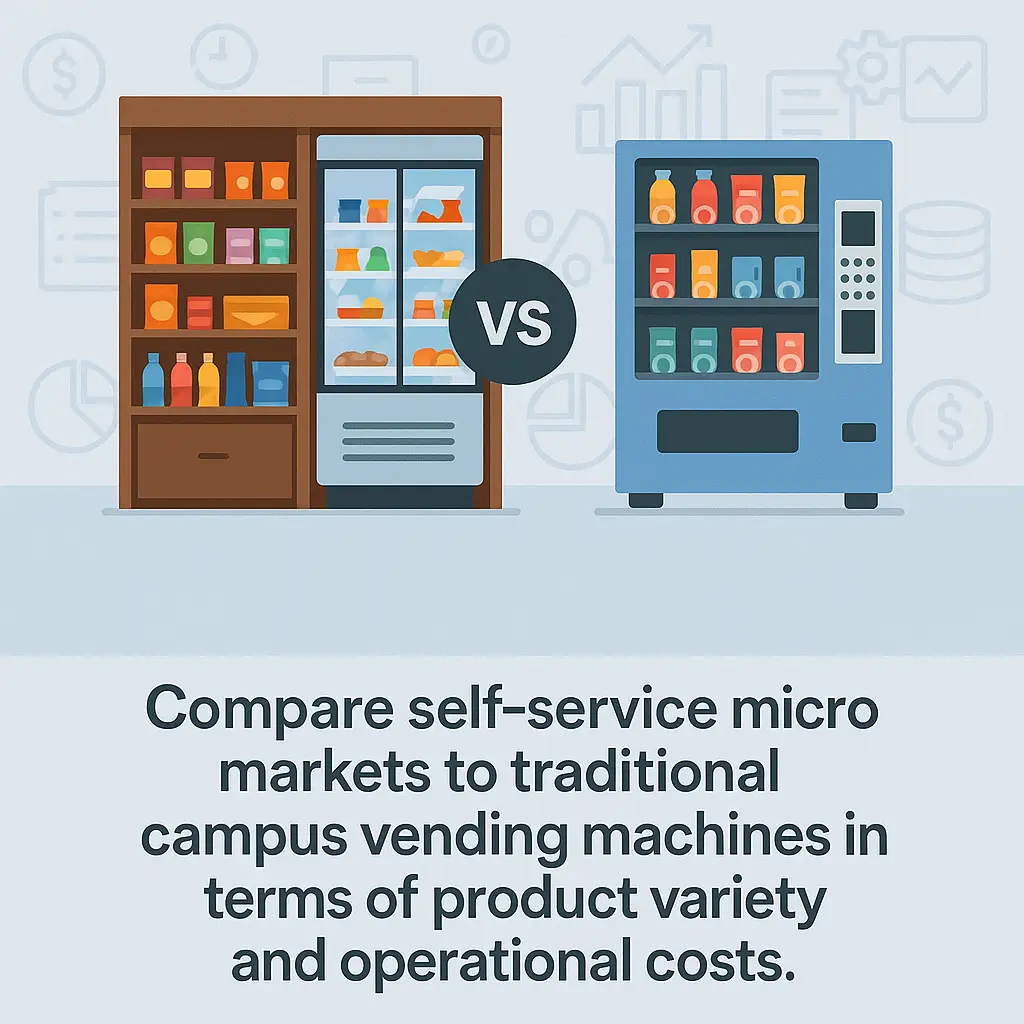Micro Markets vs Vending Machines on Campus
Compare self-service micro markets to traditional campus vending machines in terms of product variety and operational costs.
Back to Vending for Colleges ResourcesCompare self-service micro markets to traditional campus vending machines in terms of product variety and operational costs.
Back to Vending for Colleges ResourcesMicro markets resemble self-service convenience stores with more options, while vending machines provide a compact, automated solution with lower space and cost requirements.
![]() Micro markets provide wider food and beverage variety for students.
Micro markets provide wider food and beverage variety for students.
![]() Vending machines require less space and have lower setup costs.
Vending machines require less space and have lower setup costs.
![]() Both options offer contactless payments for student convenience.
Both options offer contactless payments for student convenience.

College campuses continue to evolve as student needs change, and one area seeing rapid growth is food access. The choice between micro markets and vending machines can have a significant impact on convenience, variety, and long-term costs. Understanding the differences helps schools make the best decision for their unique environment.
Micro markets function like self-service convenience stores, offering an extensive selection of snacks, beverages, fresh meals, and even personal care items. This expanded range is especially appealing to students seeking healthy or specialty options. In contrast, vending machines have more limited capacity but can still provide a dependable mix of snacks, drinks, and grab-and-go items. For schools that prioritize balanced nutrition, micro markets may be the stronger fit.
One of the main advantages of vending machines is their small footprint. They require minimal installation space and can be placed in hallways, study areas, or dormitories. Micro markets, however, need more square footage since they include shelving, refrigeration, and checkout systems. While setup is usually straightforward, schools should evaluate available space before committing to a larger format.
Vending machines generally involve lower initial setup costs compared to micro markets, making them attractive for schools with budget constraints. Micro markets may carry higher operational expenses due to technology integration and restocking needs. Schools should weigh these financial aspects carefully to ensure the solution aligns with long-term budgets. For additional context, explore how campus vending supports student life.
Both micro markets and vending machines now feature modern payment systems, including mobile and contactless options. This ensures fast, secure transactions that meet student expectations. Because micro markets often remain open 24/7, they can better serve late-night study sessions. On the other hand, vending machines are ideal for quick installations in multiple high-traffic locations, enhancing reach. Schools considering 24-hour convenience may also benefit from reviewing round-the-clock vending options.
Ultimately, the choice depends on student demand, available space, and financial priorities. Some campuses use both models strategically—vending machines in residence halls and micro markets in student centers. For deeper insight, consider comparing how residence hall vending impacts student satisfaction.
If you're exploring vending options for your business, Vending Exchange can help simplify the process. Delivery, Installation and Equipment is provided at no cost to you - vendors provide the machines, keep them stocked, and handle all servicing. Whether you need a provider or full-service management, just fill out the form on this page to get started.
Micro markets offer larger product variety and resemble self-service convenience stores, while vending machines are compact and automated.
Yes, micro markets typically require higher setup and operational costs compared to vending machines.
Vending machines are better for small spaces since they require minimal square footage.
Yes, most modern micro markets and vending machines support mobile and contactless payments.
Yes, micro markets can operate 24/7, making them useful for late-night student access.
Generally, vending machines are simpler to maintain since they involve fewer components and technology.
Micro markets provide greater flexibility for stocking fresh and nutritious options compared to vending machines.
Schools should evaluate available space, student demand, and budget before deciding.
Yes, many campuses place vending machines in dorms and micro markets in central areas.
Yes, vending machines usually involve lower upfront setup costs and less equipment.